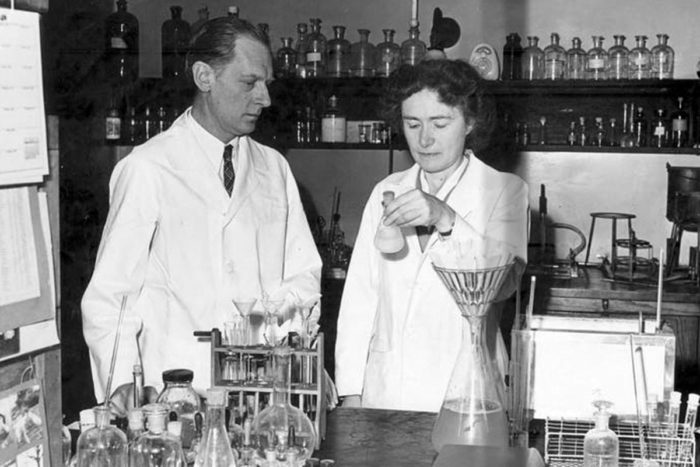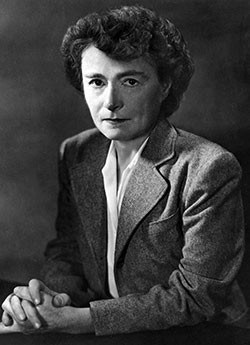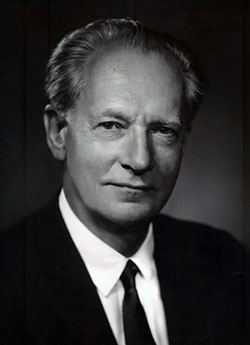Cori Nobel Prize medals donated to Washington University
Medals on display in Becker Medical Library
Huy MachThe Nobel Prize in Medicine medals awarded to Carl and Gerty Cori in 1947 for their work on sugar metabolism have been donated to Washington University by their son, Thomas Cori.
The two Nobel Prize medals awarded to Carl and Gerty Cori in 1947 for their groundbreaking medical research have been donated to Washington University in St. Louis by their son, Thomas Cori, PhD. The medals are now on permanent display at the School of Medicine’s Bernard Becker Medical Library.
“I’ve had the opportunity to hold the medals, and it’s a thrill,” said Chancellor Mark S. Wrighton. “These are treasures because the medals really symbolize a medical school that is deeply committed to advancing fundamental biomedical science that will bring great benefit to people, not only here in St. Louis but all around the world.”
The medals can be seen at the Center for the History of Medicine on the sixth floor of the Becker Medical Library on the Medical Campus. Library staff, led by Paul Schoening, associate dean and director of the Becker Medical Library, took care in preparing a location for a display that would do justice to the importance of the Coris’ work.
“Our intent was really for this to be a place where people didn’t come to see the medals in isolation, but really to come here and understand the significance of the history of the Coris, their contribution to the history of this institution and to science, and so become a little more absorbed in everything they’ve done,” Schoening said.
The Coris’ Nobel Prizes recognized their work on sugar metabolism. They discovered how the body converts glycogen – the form in which sugar is stored in the body – to glucose, a form that can be burned to provide energy. Gerty Cori was the first American woman to win a Nobel Prize in physiology or medicine, and the couple was the third husband-wife team to win Nobel Prizes together.
 Bernard Becker Medical Library, Washington University School of Medicine
Bernard Becker Medical Library, Washington University School of Medicine“The story is that when Gerty discovered the molecular identity of a key intermediate in glucose metabolism, now known as the Cori ester, she ran down the halls calling out, ‘Carly, Carly, it’s glucose-1-phosphate!’,” said Carl Frieden, PhD, who first met the Coris as a postdoctoral researcher and is now a professor of biochemistry and molecular biophysics.
Both Gerty and Carl were born in 1896 in Prague, then part of the Austro-Hungarian empire. The two met in 1914 as first-year medical students at the University of Prague, but their education was interrupted by World War I: Carl was drafted into the Austrian army and served as a medic; Gerty served as a hospital assistant. They returned to medical school after the war, graduating in 1920 and marrying that same year.
It was soon apparent that anti-Semitism would hinder their careers in Europe. Gerty was raised Jewish, and although she converted to Catholicism, it was clear that they were vulnerable to discrimination due to her Jewish heritage. They moved to the United States in 1922 and became citizens in 1928.
The Coris worked together throughout their careers and were known to say that the secret to their success was in their teamwork.
 Bernard Becker Medical Library, Washington University School of Medicine
Bernard Becker Medical Library, Washington University School of MedicineAs he accepted the Nobel Prize in 1947, Carl said his wife being included in the awarding of the prize was a source of deep satisfaction to him. “Our collaboration began 30 years ago when we were still medical students at the University of Prague and has continued ever since. Our efforts have been largely complementary, and one without the other would not have gone as far as in combination.”
Their colleagues at Washington University recalled Gerty and Carl as having very different approaches to scientific discovery, which may have laid a foundation for their laboratory successes.
“They were a remarkable pair,” David Kipnis, MD, told the American Chemical Society in 2004, when the organization designated the Coris’ research at the School of Medicine a National Historic Chemistry Landmark. “Gerty would have flights of fancy. She’d come up with extraordinary ideas. (Carl) had the ability to put them into concrete questions to answer. And therefore, as a team, they were extraordinary.” Kipnis, a former head of the Department of Medicine at Washington University, died in 2014.
“In the Coris’ time, it was unusual for two scientists to work together so closely,” said Jean Schaffer, MD, the Virginia Minnich Distinguished Professor of Medicine. “I think that their effective partnership in science provided a great model for the scientists who came after them. Today we recognize that collaborative science is very important. In so many ways, they were ahead of their time.”
Given their strength as a team, it is ironic that people tried to stop them from working together early in their careers. In 1922, when they were employed in separate departments at the State Institute for the Study of Malignant Disease in Buffalo, N.Y., they were told that working together would violate anti-nepotism rules and cost Gerty her job. Fortunately, those rules were relaxed, and the couple went on to do seminal work in New York on how the body regulates blood glucose levels.
About a decade later, when Carl was looking to leave Buffalo, they again ran into resistance to Gerty working as a scientist. According to historical accounts, Cornell University, the University of Toronto and the University of Rochester all offered Carl jobs but refused to hire Gerty. He turned them down. At Rochester, someone reportedly pulled Gerty aside to tell her that her scientific ambitions were standing in the way of her husband’s career.
In 1931, Washington University offered both Carl and Gerty positions, which likely had a great deal to do with their decision to come here, but the offers weren’t equal. Carl was offered the position of head of the Department of Pharmacology, and Gerty became a research associate, reportedly at one-tenth of Carl’s salary.
For the next 15 years, Gerty worked as a research associate as Carl rose through the ranks. When he was appointed head of the Biochemistry Department in 1946, Gerty was finally promoted to a professorship, about a year before she was awarded the Nobel Prize.
On Oct. 31, 1947, soon after the Nobel Prizes were announced, the university threw a faculty party in the Women’s Building in honor of both Coris. About 200 people attended, and the event featured speeches lauding the couple’s accomplishments.
At the School of Medicine, the Coris built a strong lab. Their research space was located in the South Building, which had ceilings 14 feet high to help manage the heat during the blazing St. Louis summers. Apart from the work that earned them their Nobel Prizes, they trained many people who became leading scientists, including six who went on to win Nobel Prizes of their own.
“At the end of World War II, St. Louis was the mecca for biochemical research,” said William H. Danforth, MD, who did postdoctoral research in Carl Cori’s lab and later became chancellor of Washington University. “More Nobel Prize winners trained in biochemistry with Carl and Gerty Cori in the decades following World War II than at any other laboratory. Carl and Gerty were the gurus of the field. There weren’t any comparable labs going – not in Europe or the United States or Asia – at the time.”
Carl and Gerty were known for their willingness to discuss science with all comers.
“They ate lunch in the library, and whoever wanted to come and sit there could eat lunch and talk with them,” Frieden said. “She would read the scientific literature and then she would bring up papers that she had read and ask for comments. I was always a bit afraid of them because they had already won their Nobel Prizes and I was just starting out, but they really tried to be helpful.”
In St. Louis, the Coris lived on North Berry Road in Glendale, in a home designed by a friend, Harris Armstrong, who went on to become a leading architect. In 1936, Gerty gave birth to the couple’s only child, Thomas, who went on to become chairman and CEO of Sigma-Aldrich Corp. in St. Louis.
 Bernard Becker Medical Library, Washington University School of Medicine
Bernard Becker Medical Library, Washington University School of MedicineThe same year the Coris won their Nobel Prizes, Gerty was diagnosed with myelofibrosis, a rare bone marrow cancer that led to her death 10 years later.
Gerty worked right up to the very end. “The love for and dedication to one’s work seem to me to be the basis for happiness,” she said on the radio series “This I Believe” in the 1950s. She died in 1957 at the age of 61.
 Bernard Becker Medical Library, Washington University School of Medicine
Bernard Becker Medical Library, Washington University School of MedicineCarl retired from Washington University in 1966, but he didn’t stop working. He moved to Boston, took a visiting professorship at Harvard Medical School and set up a lab at Massachusetts General Hospital. Like Gerty, he continued working until just before his death in 1984 at the age of 87.
Carl and Gerty Cori share a star on the St. Louis Walk of Fame and a National Historic Chemical Landmark plaque at the McKinley Avenue entrance to the South Building, where they did their work.
The Coris’ work on sugar metabolism laid the groundwork for much of modern diabetes research. Among the many diabetes researchers the Coris trained were Kipnis, who helped identify how insulin release in the pancreas is regulated, and William Daughaday, MD, who identified insulin-like growth factors. Kipnis and Daughaday helped found Washington University’s Diabetes and Endocrinology Research Center in 1975, and that center’s successor, the Diabetes Research Center, which have been instrumental in keeping the School of Medicine at the forefront of diabetes research.
 Huy Mach
Huy Mach“The Coris’ work in the biochemistry and physiology of carbohydrate metabolism really revolutionized our understanding of the field of metabolism,” said Schaffer, who is also director of the university’s Diabetes Research Center. “That, in and of itself, would have been a really amazing accomplishment, but they also attracted and trained an incredible cadre of young scientists who would go on to lead in the field of metabolism. Carl and Gerty Cori laid the foundation that allowed Washington University to become a place that is recognized for its depth and breadth of research in metabolism and diabetes.”






